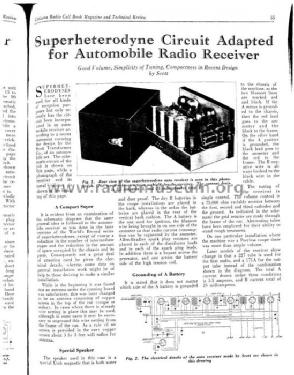Automobile Radio
Scott Radio Labs.(E.H., Transformer); Chicago (IL)
- Pays
- Etats-Unis
- Fabricant / Marque
- Scott Radio Labs.(E.H., Transformer); Chicago (IL)
- Année
- 1930
- Catégorie
- Autoradio, ev. avec cassette
- Radiomuseum.org ID
- 55382
- No. de tubes
- 7
- Principe général
- Super hétérodyne (en général)
- Gammes d'ondes
- PO uniquement
- Tension / type courant
- Piles (rechargeables ou/et sèches)
- Haut-parleur
- HP dynamique principe inconnu
- Matière
- Boitier métallique
- De Radiomuseum.org
- Modèle: Automobile Radio - Scott Radio Labs.E.H.,
- Forme
- Chassis (pour intégration dans meuble)
- Remarques
-
tubes are noted only once per type.
In Citizen Radio Callbook, Sept.1930.
- Source extérieure
- Ernst Erb
- Littérature
- E.H.Scott Radio Collectors Guide (1925-1946)
- D'autres Modèles
-
Vous pourrez trouver sous ce lien 201 modèles d'appareils, 126 avec des images et 51 avec des schémas.
Tous les appareils de Scott Radio Labs.(E.H., Transformer); Chicago (IL)
Contributions du forum pour ce modèle: Scott Radio Labs.E.H: Automobile Radio
Discussions: 1 | Publications: 1
The only reference to auto radios is found in the September, 1930 issue of the Citizen’s Radio Callbook. In a single page article entitled “Superheterodyne Circuit Adapted for Automobile Radio Receiver”, Scott described his automobile radio.
The set is battery operated, obtaining ‘A’ voltage from the ignition battery, and ‘B’ cells in the back. The antenna could be either a copper mesh in the ceiling or a wire hidden in the running board. A small schematic is given, showing the following tubes: two type 27 tubes in the oscillator and second detector, three type 24 tubes for the first detector and two IF stages, a 71A as the first audio stage and a 45 as the final audio. Even using these seven tubes, Scott claimed the set only drew 25mA from the ‘B’ cells. The article leads one to believe that several sets might have been built. The last paragraph states that “later models of the receiver show change in that a 227 tube is used for the first audio, and a 171A for the output instead of the combination shown in the diagram”. The article also mentions that a special water and dust proof
Kent King, 02.Sep.06
